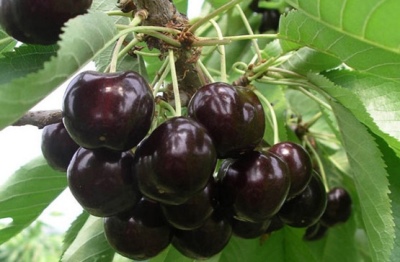
- Authors: AND I. Voronchikhina (Rossoshanskaya zonal experimental gardening station)
- Year of approval: 1986
- Barrel type: wood
- Growth type: medium-sized
- Crown: spherical-raised, compact, medium size
- Foliage: medium or weak
- Fruit size: above the average
- Fruit shape: rounded
- Fruit color: dark cherry, almost black
- Fruit weight, g: 4,0-4,5
Cherries differ in the color of the berries: there are dark red, burgundy, closer to black. They are called morel, while the amorel has a red skin and colorless juice. Many people prefer dark-fruited cherries. Among them stands out Rossoshanskaya black, ideal for cultivation in the central part of Russia.
Breeding history
This variety has been known for a very long time. The author of this attractive variety is the breeder A. Ya. Voronchikhina. The work was carried out on the plantations of the Rossoshan Experimental Gardening Station, which is where the name of the variety came from. Genetic material for steel selection:
- Consumer goods black (representing the paternal line Michurin variety);
- Form number 2.
An application for admission of Rossoshanskaya black to cultivation was made in 1973. Since 1974, the crop has been undergoing state tests. The variety was included in the State Register of the Russian Federation in 1986. Almost immediately, Rossoshanskaya black became a popular crop both in private gardens and for industrial cultivation.
Description of the variety
Cherry trees are medium-sized, can grow up to 4 m. The medium-sized crown is spherical-raised, compact. The bark is gray; upon reaching a certain age, it turns black, and the branches become bare. The leaves are about 10 cm long and 5 cm wide.
Fruit characteristics
The fruits are above average in size, reaching a weight of 4.5 g. They are round in shape, slightly flattened on the sides. The skin is dark cherry, almost black. The separation of the berries from the stalk is dry. The flesh of the fruit also has a dark color, it is dark red, very juicy, with a dense consistency.
Taste qualities
Cherries are sweet and sour, many people note their pleasant, good taste, so the fruits are often consumed fresh. The product is suitable for culinary processing into delicious jam, excellent blanks are obtained from it, such as jam, liqueur, compote. Due to their density, the fruits are suitable for canning. Technologists-tasters highly appreciated the quality of the berries: for example, the appearance of the cherry compote was rated at 4.7, and the taste characteristics at 4.3 out of 5 points. Fruit qualities such as juiciness and meatiness of the pulp, sweet and sour taste are suitable for wide industrial production of delicious cherry products.
Ripening and fruiting
The culture begins to bear fruit 3-4 years after planting. The ripening time of the culture is average. The harvest ripens in the 3rd June decade.

Yield
The productivity of the crop is quite high: an average of 15 kg of berries from each tree. In a good year, the crop can produce about 25 kg of berries per tree.
Growing regions
Rossoshanskaya black zoned initially for such regions as:
- Central;
- Nizhnevolzhsky;
- North Caucasian.
Today, the cherry in question has a wider geography of distribution. It can be found in private and farm gardens, not only in the listed regions, but also in areas such as Volgograd, Rostov, as well as in the middle lane on rich chernozem soils.
Self-fertility and the need for pollinators
The culture in question is self-fertile. To increase yields, it is good that pollinating varieties grow nearby, in which flowering occurs at the same time as Rossoshanskaya black.
Landing
Basically, the planting time for the Rossoshansk black seedling is autumn. However, closer to the south, you can plant this varietal cherry in the spring. The main thing is to choose a lighted area so that the soil on it is non-acidic, preferably loam. The ideal place for planting Rossoshanskaya black is not a very large hill near a brick wall that can accumulate heat.


Growing and caring
An adult Rossosh black cherry tree is watered only a few times (3-4) during the growing season. Watering should be plentiful so that the liquid reaches the ground to a depth of 50-60 cm. Irrigation should be commensurate with the precipitation that will fall, in order to avoid excessive moisture. An obligatory component of care is preventive treatment of the plant from the main ailments and attacks of insect pests.


Requirements for soil and climatic conditions
The variety boasts not only average winter hardiness of wood, but also high frost resistance of flower buds. Trees endure exposure to low temperatures with minimal losses (within 10% of freezing of flower buds). The cherries have an average drought resistance. If there is a prolonged lack of moisture, lack of regular watering, the tree may even die.
































































